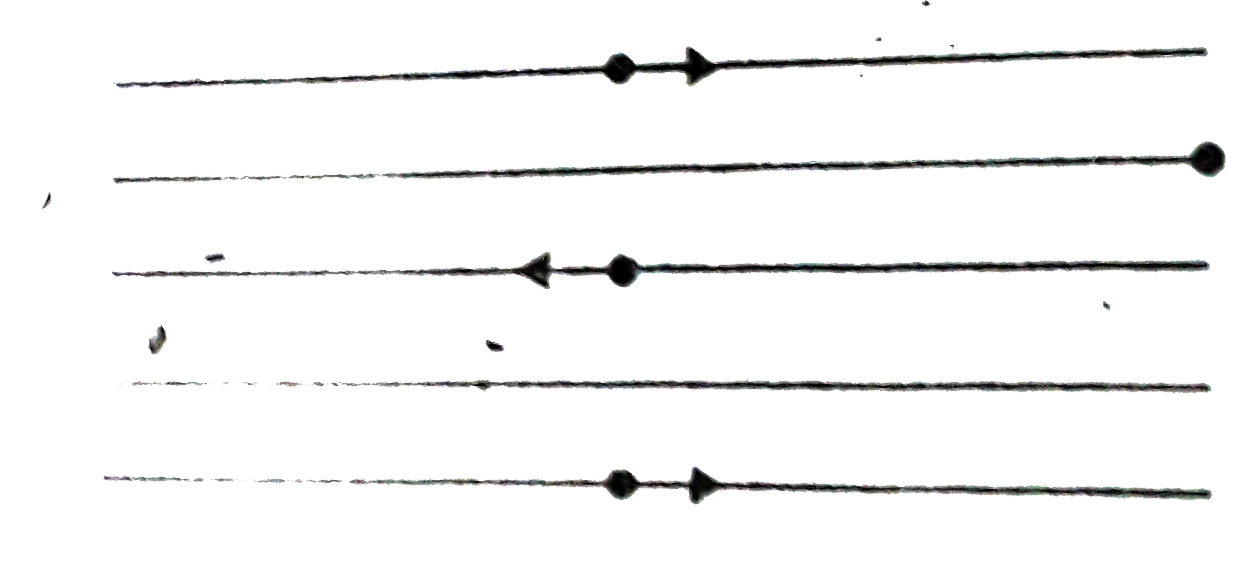In the figure, dots and arrows show the position and the velocity of a paritcle executing SHM. What are the phases at the five indicated instants when the position at time t is given by
x=Asin(ωt+ϕ)

When x=Asin(ωt+ϕ)
thenv=Aωcos(ωt+ϕ)
(i) x=0 , so sin(ωt+ϕ)=0, hence cos(ωt+ϕ)=±1
∴V=±Aω
Since the arrow is directed towards right, v=+Aω
So,cos(ωt+ϕ)=+1⇒δ=ωt+ϕ=2nπ
sin(ωt+ϕ)=0⇒δ=nπ
Hence both will be satisfies when δ=2nπ
whenn=0,±1,±2,±3.....
(ii) x=+A⇒sin(ωt+ϕ)=1⇒δ=ωt=ϕ=2nπ+π2
v=0⇒cos(ωt+ϕ)=0⇒δ=2nπ±π2
combining these two, we get δ=2nπ+π2
(iii) x=0⇒sin(ωt+π)=0⇒δ=ωt+π=nπ
v=−Aω⇒cos(ωt+ϕ)−1⇒δ=ωt+ϕ=2nπ+π
Combining these two general values of δ , we get
δ=(2n+1)π=2nπ−π
(iv) x=−A⇒sin(ωt+ϕ)=−1⇒δ=2nπ+3π2
v=0⇒cos(ωt+ϕ)=0⇒δ=2nπ+π2 or 2nπ+3π2
∴δ=2nπ+3π2
(v)x=0,v=+Aω⇒δ=ωt+ϕ=2nπ+2π
Topper's Solved these Questions
- OSCILLATIONSBook:AAKASH INSTITUTEChapter:OSCILLATIONSExercise:Exercise
Explore 20 Videos
- OSCILLATIONSBook:AAKASH INSTITUTEChapter:OSCILLATIONSExercise:Assignment (Section - A) (OBJECTIVE TYPE QUESTIONS)
Explore 60 Videos
- OSCILLATIONSBook:AAKASH INSTITUTEChapter:OSCILLATIONSExercise:ASSIGNMENT ( SECTION-J )
Explore 8 Videos
- NUCLEIBook:AAKASH INSTITUTEChapter:NUCLEIExercise:ASSIGNMENT (SECTION-D)
Explore 10 Videos
- PHYSICAL WORLDBook:AAKASH INSTITUTEChapter:PHYSICAL WORLDExercise:ASSIGNMENT (Section-B)
Explore 5 Videos
Similar Questions
A particle executes simple harmonic motion of amplitude A along the x - axis. At t=0, the position of the particle is x=A2 and it moves along the positive x - direction. Find the phase contant δ, if of the equation is written as x=Asin(ωt+δ).
View SolutionA particle is executing SHM. It passes through mean position at the instant t=0. At what instants the speed of it is 50% of its maximum speed?
View Solution
Knowledge Check
The time period of a particle executing SHM is T. After a time T/6 after it passes its mean position, then att=0 its :
Adisplacement will be one-half of its amplitudeBvelocity will be one-half of its maximum velocityCkinetic energy =1/3 (potential energy)Dacceleration will be √32 times of its maximum accelerationThe figure shows the positions and velocity of two particle. If the paritcle move under the mutual attraction of each other, then the position of centre of mass at t=1s is :-
 Ax=5mBx=6mCx=3mDx=2m
Ax=5mBx=6mCx=3mDx=2mThe equation of a particle executing a S.H.M. is given by x=4sinωt+5cosωt. The "tan"gent of the initial phase angle is given by
Atanα=23Btanα=1Ctanα=54Dtanα=45
A particle executing SHM of amplitude 4 cm and T=4s .The time taken by it to move from position to half the amplitude is
View SolutionThe equation of a particle executing SHM is d2xdt2=−ω2x. Where ω=2πtime period. The velocity of particle is maximum when it passes through mean position and its accleration is maximum at extremeposition. The displacement of particle is given by x=Asin(ωt+θ) where θ-initial phase of motion. A-Amplitude of motion and T-Time period
The time period of pendulum is given by the equation T=2π√lg. Hered2xdt2 is :
View SolutionThe equation of a particle executing a linear S.H.M. is given by x=4cosωt+sinωt. The "tan"gent of its initial phase angle is given by
View SolutionA particle is executing SHM with time period T Starting from mean position, time taken by it to complete 58 oscillations is,
View SolutionThe equation of a particle executing SHM is d2xdt2=−ω2x. Where ω=2πtime period. The velocity of particle is maximum when it passes through mean position and its accleration is maximum at extremeposition. The displacement of particle is given by x=Asin(ωt+θ) where θ-initial phase of motion. A-Amplitude of motion and T-Time period
The average velocity during motion of particle from one extreme point:
View Solution